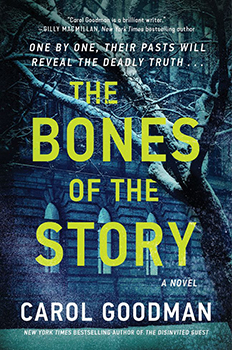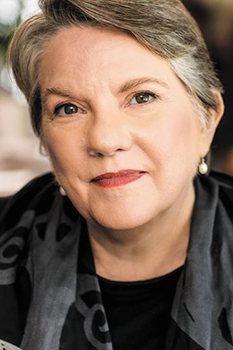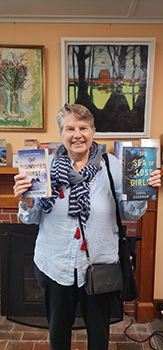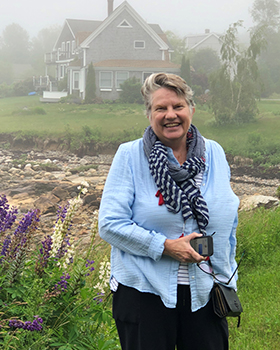

Features Carol Goodman
Revenge of The Raven Society
 By K.L. Romo
By K.L. Romo
Bestselling author Carol Goodman celebrates the release of her 25th novel, THE BONES OF THE STORY, with a 25-year-old missing persons case that emerges in a vengeful locked-room thriller.
“There’s no amount of good you can do that will ever make up for what you did.”
This is the familiar self-recrimination that invades Nell Portman’s mind. As the Dean of Liberal Arts at Briarwood College, she’s constantly reminded of what happened when she was a student at the same college 25 years before.
Nell had been part of the elite Raven Society, a group of gifted writers lucky enough to work with Briarwood’s famous, although eccentric, writer-in-residence, Hugo Moss. Every Liberal Arts student wanted to belong to the Raven Society, even enough to sabotage other competitors. On that night a quarter of a century ago, Moss and one of the Raven members disappeared into the night and were never found.
Now, the president of Briarwood has planned a 25th-anniversary gathering to commemorate Moss’s disappearance, with Moss’s last class of students invited to stay the weekend. Nell is one of them; bestselling author Laine Bishop is another. It soon becomes clear that one of their classmates from long ago seeks revenge.
Goodman talked with The Big Thrill about the novel, college experiences, and the slippery slope of competition.
Happy 25th anniversary! When you began your writing career, did you envision 25 books and counting?
No! I knew I wanted nothing more than to keep writing, but I didn’t take for granted I’d be able to do that. And if I’d tried to imagine 25 book plots, I would have been overwhelmed. I feel incredibly fortunate that I’ve had the support to keep writing.
Your book is based on the bonds made in college. Did you have similar college experiences (minus the dead bodies)?
I made great friends in college, and, in fact, during the pandemic, a bunch of us started a weekly Zoom that’s still going on. We talked about everything—current events, our present lives, politics—but of course, we would also reminisce. Upon hearing about those days from a lot of different perspectives—some from close friends and some from people I hadn’t known that well —I realized it had been a different experience for each of us, and I had missed a lot of what people went through. While nothing terrible happened to us—like what happens to Nell and her friends—I thought about what I might have missed. I dedicated the book to “old college friends, forever young in my heart.”
What about college traditions that get out of hand and become dangerous? Did that ever happen to you while in college?
Again, nothing so dramatic and dangerous as the luminaria and those ice cave excursions. However, when I think of some of our escapades—scaling buildings, cocktail parties on rooftops—I’m amazed we all survived. The tradition that inspired the black feather event in the book was the selection of the sophomore Daisy Chain. At graduation each year, a group of chosen sophomores carried a daisy chain. I applied for the daisy chain my sophomore year, thinking it would be cool but really having no idea what the criteria were (when the selection committee asked me what ‘club work’ I’d done, I had to admit none). Near the end of the year, ‘the chosen’ would find a daisy in their mailbox. Suffice it to say, there was no daisy in my mailbox. It wasn’t as dramatic as the black feather ceremony in my book, but I pulled from that feeling of public disappointment to create that scene.
Should there be such competitive programs in college that pit students against each other?
I don’t think there’s anything wrong with contests in which excellence is rewarded, such as in sporting events or literary contests, but there’s no need to make it all about competition. Certainly, I don’t think the classroom is the place for that. I would never encourage the kind of competition in my creative writing classes that Hugo encourages in his.
What messages would you like readers to take away from the book?
Look around you. People are struggling in ways we don’t see because we’re so wrapped up in our own problems. And stay out of ice caves.
Do you identify with Dean Portman in any way?
I identify with her love of reading and writing and her concern for the students she works with. I put a lot of my own awkward beginnings in college into her experience. In the present narrative, though, she’s way more organized and competent in a demanding administrative role than I’ve ever had to be. For that part of her character, I drew on my dear friend, Dr. Nancy Johnson, Associate Dean of Liberal Arts at SUNY New Paltz, who is a model of decorum and diplomacy.
Do you have a favorite college story you’d like to share?
During my first semester of freshman year, my friend Connie Crawford, who lived in my hall and was the first friend I made at Vassar, applied for the Saturday Night Live Anyone Can Host contest. She asked me to take Polaroid pictures of her to send with her application (which was her college ID stapled to a postcard with “Free Me” scrawled beneath), and we wandered the campus taking imaginative pictures. She made the finals!
Our friend Gary Feinberg and I drove Connie to the train station and then ran along the platform like we were in some WWII movie, and she was shipping out to the front. Then Gary and I ran all over campus, putting up posters urging people to vote for her. We all watched the show in the lounge of our dorm. Connie didn’t win, but the excitement and community spirit her participation engendered was something new for me (I’d been a cynical, too-cool-for-school teenager in high school). It made college seem magical and like anything could happen.
Can you share a teaser about your next novel?
It’s about a young editorial assistant at a small publishing company who’s sent upstate to a haunted mansion to work on the sequel to a bestselling gothic suspense novel.
- The Big Thrill Recommends: WHAT YOU LEAVE BEHIND by Wanda M. Morris - June 27, 2024
- Sally Hepworth - May 10, 2024
- Katherine Ramsland - April 25, 2024



